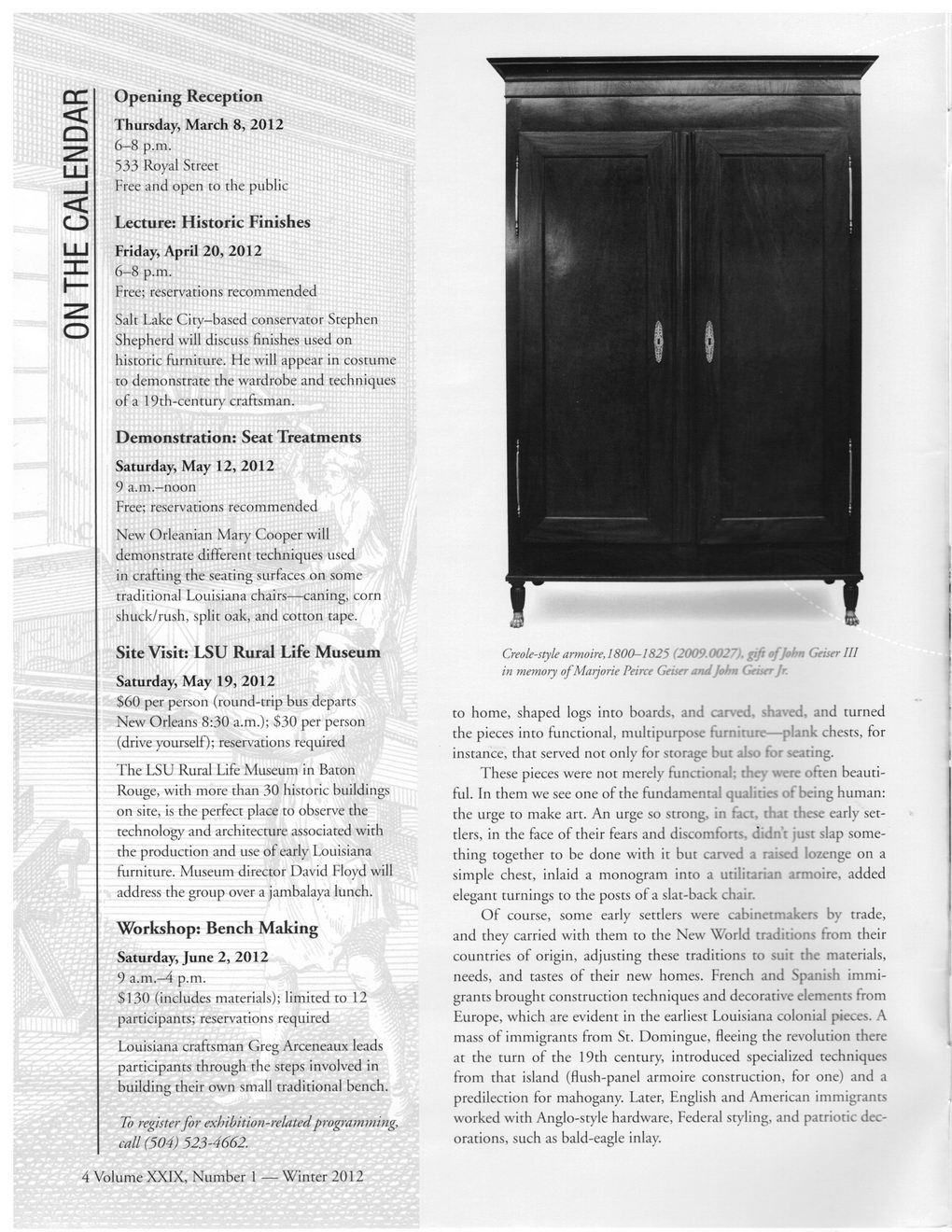This text was obtained via automated optical character recognition.
It has not been edited and may therefore contain several errors.
ON THE CALENDAR Opening Reception Thursday, March 8, 2012 6—8 p.m. 533 Royal Street Free and open to the public Lecture: Historic Finishes Friday, April 20, 2012 6-8 p.m. Free; reservations recommended Salt Lake City-based conservator Stephen Shepherd will discuss finishes used on historic furniture. He will appear in costume to demonstrate the wardrobe and techniques of a 19th-century craftsman. Demonstration: Seat Treatments Saturday, May 12, 2012 9 a.m.—noon Free; reservations recommended New Orleanian Mary Cooper will demonstrate different techniques used in crafting the seating surfaces on some traditional Louisiana chairs—caning, corn shuck/rush, split oak, and cotton tape. Site Visit: LSU Rural Life Museum Saturday, May 19, 2012 $60 per person (round-trip bus departs New Orleans 8:30 a.m.); $30 per person (drive yourself); reservations required The LSU Rural Life Museum in Baton Rouge, with more than 30 historic buildings on site, is the perfect place to observe the technology and architecture associated with the production and use of early Louisiana furniture. Museum director David Floyd will address the group over a jambalaya lunch. Workshop: Bench Making Saturday, June 2, 2012 9 a.m.-4 p.m. $130 (includes materials); limited to 12 participants; reservations required Louisiana craftsman Greg Arceneaux leads participants through the steps involved in building their own small traditional bench. To register for exhibition-related programming, call (504) 523-4662. Creole-style armoire, 1800-1825 (2009.0027), gift tfjthi Geiser III in memory ofMarjorie Peirce Geiser andJohn Geiser Jr. to home, shaped logs into boards, and carved, shaved, and turned the pieces into functional, multipurpose furniture—plank chests, for instance, that served not only for storage but also for seating. These pieces were not merely functional; they were often beautiful. In them we see one of the fundamental qualities of being human: the urge to make art. An urge so strong, in fact, that these early settlers, in the face of their fears and discomforts, didn’t just slap something together to be done with it but carved a raised lozenge on a simple chest, inlaid a monogram into a utilitarian armoire, added elegant turnings to the posts of a slat-back chair. Of course, some early settlers were cabinetmakers by trade, and they carried with them to the New World traditions from their countries of origin, adjusting these traditions to suit the materials, needs, and tastes of their new homes. French and Spanish immigrants brought construction techniques and decorative elements from Europe, which are evident in the earliest Louisiana colonial pieces. A mass of immigrants from St. Domingue, fleeing the revolution there at the turn of the 19th century, introduced specialized techniques from that island (flush-panel armoire construction, for one) and a predilection for mahogany. Later, English and American immigrants worked with Anglo-style hardware, Federal styling, and patriotic decorations, such as bald-eagle inlay. 4 Volume XXIX, Number 1 — Winter 2012

New Orleans Quarterly 2012 Winter (04)